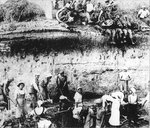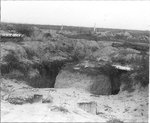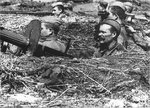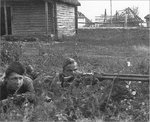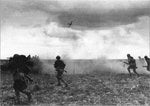Navigation
Install the app
How to install the app on iOS
Follow along with the video below to see how to install our site as a web app on your home screen.
Note: This feature may not be available in some browsers.
More options
You are using an out of date browser. It may not display this or other websites correctly.
You should upgrade or use an alternative browser.
You should upgrade or use an alternative browser.
The Battle of Kursk - Biggest clash of armor.
- Thread starter JugBR
- Start date
Ad: This forum contains affiliate links to products on Amazon and eBay. More information in Terms and rules
More options
Who Replied?CharlesBronson
Senior Master Sergeant
parsifal
Colonel
Fantastic pics Charles!!! What is the source????
CharlesBronson
Senior Master Sergeant
Thank you.
Source is "Images of Kursk: History's Greatest Tank Battle" By Nicholas Kornish.
German weekly newsreel dealing with the battle, very good footage of german armor and self propelled artillery.
Left clik only
Wochenschau-Archiv
Source is "Images of Kursk: History's Greatest Tank Battle" By Nicholas Kornish.
German weekly newsreel dealing with the battle, very good footage of german armor and self propelled artillery.
Left clik only
Wochenschau-Archiv
parsifal
Colonel
The air battle at Kursk is very interesting, and because of the lack of hard data on losses, a still very much disputed battle as to outcome and impact (on the ground campaign). there are many that argue the VVS was inneffective in the battle, and that throughout the LW continued to dominate. I respect that point of view, but i dont agree with it.
My basic position on the air battle is that in many ways it mimicked the the ground campaign. The Soviets were still far behind the Germans in terms of qualitative edge. However they now enjoyed a considerable quantitative edge 9they had that previously as well, but now they possessed sufficient grasp of Command Control Issues as to exploit that advantage properly. At the beginning of the battle the Soviets actually deployed less aircraft into the battle zone than the germans, about 1800 aircraft, but they were supported by a further 5-6000 aircraft outside the salient, and more importantly outside the range of a german pre-emptive strike. That was not the limit of Soviet reserves....these are just the front line units. There were about 8000 airframe replacements behind that as well. In comparison, the german replacement parks and reserve units were virtually nil
The Russians attempted a pre-emptive strike themselves, which failed dismally, however the battle of attrition that their deployments obviously were geared towards did eventuate, The result was that whilst the germans started with a very high success and sortie rate, as the battle progressed the german sortie rate plummetted, as spares and replacements ran out very quickly, and the balance of forces began to tip in favour of the Russians. Losses i think at the end of July were running still slightly in the germans favour, but the gap was narrowing very fast. This will no doubt be disputed, and frankly there are not reliable figures on osses for the russians particularly. However the Germans sorite rates were down to about a quarter of the levels being achieved at the beiginning of the battle. Soviet sortie rates reflected the huge reserves that they possessed. My best estimate is that by the end of the battle, the Soviet sortie rate was about 8 times that of the germans, and consequesntly air superiority had in fact passed to the Soviets, despite the heavy attrition being inflicted by the Luftwaffe. For the Soviets, the important thing was not so much the killing of the Luftwaffe, as achieving the primary misssion of supporting their advancing ground formations. I think they achieved this objective in spades. There conduct of the battle, given the limitations of qualtity, and their advantages in numbers and support, was near perfect, IMO
My basic position on the air battle is that in many ways it mimicked the the ground campaign. The Soviets were still far behind the Germans in terms of qualitative edge. However they now enjoyed a considerable quantitative edge 9they had that previously as well, but now they possessed sufficient grasp of Command Control Issues as to exploit that advantage properly. At the beginning of the battle the Soviets actually deployed less aircraft into the battle zone than the germans, about 1800 aircraft, but they were supported by a further 5-6000 aircraft outside the salient, and more importantly outside the range of a german pre-emptive strike. That was not the limit of Soviet reserves....these are just the front line units. There were about 8000 airframe replacements behind that as well. In comparison, the german replacement parks and reserve units were virtually nil
The Russians attempted a pre-emptive strike themselves, which failed dismally, however the battle of attrition that their deployments obviously were geared towards did eventuate, The result was that whilst the germans started with a very high success and sortie rate, as the battle progressed the german sortie rate plummetted, as spares and replacements ran out very quickly, and the balance of forces began to tip in favour of the Russians. Losses i think at the end of July were running still slightly in the germans favour, but the gap was narrowing very fast. This will no doubt be disputed, and frankly there are not reliable figures on osses for the russians particularly. However the Germans sorite rates were down to about a quarter of the levels being achieved at the beiginning of the battle. Soviet sortie rates reflected the huge reserves that they possessed. My best estimate is that by the end of the battle, the Soviet sortie rate was about 8 times that of the germans, and consequesntly air superiority had in fact passed to the Soviets, despite the heavy attrition being inflicted by the Luftwaffe. For the Soviets, the important thing was not so much the killing of the Luftwaffe, as achieving the primary misssion of supporting their advancing ground formations. I think they achieved this objective in spades. There conduct of the battle, given the limitations of qualtity, and their advantages in numbers and support, was near perfect, IMO
CharlesBronson
Senior Master Sergeant
The russians claimed a huge number of Panzer destroyed by shturmovik but also the same russians after the war recognized that only 8% of german tank and self propelled guns casualties were due the air attack by VVS, I have good a link in some place, let me see if I can found it.
Attachments
Njaco
The Pop-Tart Whisperer
B-17engineer
Colonel
what plane is that in the background ?
CharlesBronson
Senior Master Sergeant
An Il-2 obviously.
B-17engineer
Colonel
Well sorry..........
parsifal
Colonel
If the Russians were able to destroy 8% of the total Tank casualties by air attack, they would easily be the most efficient Tank Busting air force in the world at that time. The Germans, by comparison were killing about 5.5% of tank Casulatiers by Stukas.
Killing thnings by air attack is about the least important thing that ground attack aircraft do. They keep the enemy pinned, , spot for the ground forces, and generally harrass and dislocate the enemy. The Soviets were the masters at that level of co-operation, simply because they would select a section of the front, and swamp it with numbers. There was basically nothing the Germans could do about that tactic. Even though the germans retained individual qualitative advantage over the Russian pilots, they could not paralyse the battlefield in the same way as the VVS could. Shooting down large numbers of Russians was irelevant, if the russians were still achieving their mission. Shooting up large numbers of Russian AFVs was pointless, if the Russians were still overrunning the ground (and presumably recovering and often repairing the disabled tanks). And I am even doubtful that the killing spree so often promoted by the german sources is all that credible. I think the russians were starting to shoot back, with increasing effectiveness, from Kursk onwards.
Killing thnings by air attack is about the least important thing that ground attack aircraft do. They keep the enemy pinned, , spot for the ground forces, and generally harrass and dislocate the enemy. The Soviets were the masters at that level of co-operation, simply because they would select a section of the front, and swamp it with numbers. There was basically nothing the Germans could do about that tactic. Even though the germans retained individual qualitative advantage over the Russian pilots, they could not paralyse the battlefield in the same way as the VVS could. Shooting down large numbers of Russians was irelevant, if the russians were still achieving their mission. Shooting up large numbers of Russian AFVs was pointless, if the Russians were still overrunning the ground (and presumably recovering and often repairing the disabled tanks). And I am even doubtful that the killing spree so often promoted by the german sources is all that credible. I think the russians were starting to shoot back, with increasing effectiveness, from Kursk onwards.
CharlesBronson
Senior Master Sergeant
I found the link it said 4 or 5 % not 8% as I said before.
A rough translation with babelfish
This is why Germans and Americans for dealing with the tanks attempted to place on the aircraft the being rocked parts of 501 mm - 75- mm of antitank guns. In the majority of the cases of gun these were semiautomatic, but this did not have vital importance, since aiming shot could be nevertheless one. As a whole in the time of war the combat losses of Soviet average and heavy tanks on I see weapons of destruction they comprised: from artillery 88- 91%; from the mines and the contact mines it is eighth 4%; from bombs and artillery fire of aviation 4 - 5%. Although in the separate operations of loss to the fire of aviation reached to 10-15%.
NS 37
Other aircraft that performed very well in Kursk against light armor and soft skinned vehicles was the Hs-129.
Вот почему немцы и американцы для борьбы с танками пытались ставить на самолеты качающиеся части 501 мм — 75-мм противотанковых пушек. В большинстве случаев пушки эти были полуавтоматические, но это не имело существенного значения, так как прицельный выстрел мог быть все равно один.
В целом за время войны боевые потери советских средних и тяжелых танков по видам средств поражения составили: от артиллерии 88—91 %; от мин и фугасов 8— 4 %; от бомб и артогня авиации 4—5 %. Хотя в отдельных операциях потери от огня авиации доходили до 10—15%.
A rough translation with babelfish
This is why Germans and Americans for dealing with the tanks attempted to place on the aircraft the being rocked parts of 501 mm - 75- mm of antitank guns. In the majority of the cases of gun these were semiautomatic, but this did not have vital importance, since aiming shot could be nevertheless one. As a whole in the time of war the combat losses of Soviet average and heavy tanks on I see weapons of destruction they comprised: from artillery 88- 91%; from the mines and the contact mines it is eighth 4%; from bombs and artillery fire of aviation 4 - 5%. Although in the separate operations of loss to the fire of aviation reached to 10-15%.
NS 37
Other aircraft that performed very well in Kursk against light armor and soft skinned vehicles was the Hs-129.
Njaco
The Pop-Tart Whisperer
There was basically nothing the Germans could do about that tactic. Even though the germans retained individual qualitative advantage over the Russian pilots, they could not paralyse the battlefield in the same way as the VVS could.
Sometimes it worked.
8 July 1943
The Russian attack began in the morning, moving west in an attempt to cut the Begorod-Oboian highway. Along the woods north of Belgorod, Gruppenkommandeur Hptm. Bruno Meyer, flying a Hs 129B of IV./SG 9, spotted moving Russian tanks and large concentrations of troops in the attack on the German flank. Meyer radioed to base that he saw at least 40 tanks and, "....dense blocks of infantry, like a martial picture from the middle ages." and ordered the rest of his Gruppe up from Mikoyanovka to assault the Russian attack.
....The Luftwaffe immediately scrambled 4 squadrons, a total of 64 Hs 129s, to Meyer's coordinates. Using high-velocity 30mm cannons, the planes swept the forset, pumping shells into the rears of the tanks. Within a few minutes, half a dozen tanks were destroyed and burning. Fw 190 fighters joined the fray, strafing infantry and bombing wherever the Soviets were clustered. Follow up attacks by squadrons led by Major Matuschek, Oblt. Oswald, Oblt. Dornemann and Lt. Orth along with attacks on the infantry by Major Druschel's Fw 190 jabos, soon destroyed the Russian brigade and they retreated into the woods. The Soviet armoured assault had been blunted solely through air power.
CharlesBronson
Senior Master Sergeant
Yes, is that episode exactly the one wich I had in mind when I wrote my earlier post, Thanks Njaco.
Njaco
The Pop-Tart Whisperer
Thanks Bronson.
And the closest thing on stats I have found is this.
from "Hitler's Luftwaffe" by Tony Wood / Bill Gunston pg 80,
"During the opening phases of Zitadelle, the Luftwaffe flew over 3,000 sorties a day, with each servicable Ju 87D flying up to 5-6 missions per day. This effort decreased to around 1,500 sorties per day after the first week and then averaged 1,000 per day for the remainder of July. The Jagdgruppen claimed 432 kills on the first day, of which II./JG 3 claimed 77 kills, including 62 bombers, and III./JG 52 shot down 38 Soviet aircraft. German losses on the first day of Zitadelle amounted to only 26 aircraft. In total, the Luftwaffe flew 37,421 sorties throughout the battle, destroying 1,736 enemy aircraft for the loss of 64. Twenty thousand tons of bombs were dropped and Fliegerkorps I alone claimed 1,100 tanks and 1,300 vehicles."
And the closest thing on stats I have found is this.
from "Hitler's Luftwaffe" by Tony Wood / Bill Gunston pg 80,
"During the opening phases of Zitadelle, the Luftwaffe flew over 3,000 sorties a day, with each servicable Ju 87D flying up to 5-6 missions per day. This effort decreased to around 1,500 sorties per day after the first week and then averaged 1,000 per day for the remainder of July. The Jagdgruppen claimed 432 kills on the first day, of which II./JG 3 claimed 77 kills, including 62 bombers, and III./JG 52 shot down 38 Soviet aircraft. German losses on the first day of Zitadelle amounted to only 26 aircraft. In total, the Luftwaffe flew 37,421 sorties throughout the battle, destroying 1,736 enemy aircraft for the loss of 64. Twenty thousand tons of bombs were dropped and Fliegerkorps I alone claimed 1,100 tanks and 1,300 vehicles."
parsifal
Colonel
Thers always exceptions, even big ones, and the germans may still have won, if they could get their high command to fight the war properly. even though Russian reserves were huge, they were not bottomless, If the germans could have lifted the attrition rate even higher, perhaps the Russians might have run out of steam
parsifal
Colonel
Thanks Bronson.
And the closest thing on stats I have found is this.
from "Hitler's Luftwaffe" by Tony Wood / Bill Gunston pg 80,
"During the opening phases of Zitadelle, the Luftwaffe flew over 3,000 sorties a day, with each servicable Ju 87D flying up to 5-6 missions per day. This effort decreased to around 1,500 sorties per day after the first week and then averaged 1,000 per day for the remainder of July. The Jagdgruppen claimed 432 kills on the first day, of which II./JG 3 claimed 77 kills, including 62 bombers, and III./JG 52 shot down 38 Soviet aircraft. German losses on the first day of Zitadelle amounted to only 26 aircraft. In total, the Luftwaffe flew 37,421 sorties throughout the battle, destroying 1,736 enemy aircraft for the loss of 64. Twenty thousand tons of bombs were dropped and Fliegerkorps I alone claimed 1,100 tanks and 1,300 vehicles."
In fact Russian actual losses on the first day, just over the Kursk sector, according to Hardesty (who says he bases his figures on Russian sources), were just 176 aircraft. Soviet claims on the 1st day were 260 aircraft, which even hardesty says are too high. by the end of the first week, Soviet claims amounted to 854 aircraft, which is patently incorrect. Soviet sources also say that Luftwaffe losses to the 1st week in August amounted to 1400 a/c. this is also an exaggeration. However, Soviet admitted losses in that same periood is just 566 aircraft.
Hardesty estimatre German losses July was 487, and he accepts the figure of 566 aircraft losses for the Soviets. this at least looks more relaistic to me, but the actual figures are spongy and unreliable, mostly because the postwar accounts are just a regurgitation of LW wartime claims and estimates, and the Soviets/Russians have proven reluctant, or unable to cite consistent and realistc figures and claims for losses. Evidently, even 70 years on, its a sensitive subject
There is absloutely no way that german losses for the entire battle amounted to just 64. Put a 0 at the end of that and you might be getting closer
Njaco
The Pop-Tart Whisperer
I agree. It was the only thing I've found so far on stats. It does seem out of kilt. What it doesn't say is the time frame. Was it just July? When did the battle officially end? Need some parameters.
parsifal
Colonel
I admit that I dont have reliable figures for losses for either side. But the claims and counter claims from both sides are just unbelievable at times, and thats frustraing. Sorry, I didnt mean, or imply to take it out on you (or anybody really, its not our fault), but it would just be nice to get a set of figures that seemed realistic.....
This is what I think can be said
1) The germans were superior qualitatively by a wide margin, and this continued for most of the war. This meant that a few German airraft could often inflict disproportional losses on the Soviets
2) Soviet Command Control, and the general standard of training had improved sufficiently from the wars beginning, until Kursk, to the point that the Soviet air assets were now a significant factor in the ground war. The Soviets previously (ie in 1942) had the numbers, but were still inneffective in the air, because of very poor pilot standards, poor servieability rates, and extremely poor C&C. By 1943 serviceability rates were up, pilot training and tactics had improved, and the command and control of assets had vastly improved.
3) From Kursk onward, the GENERAL trend was for the VVS to have an increasing efect on the outcome of the ground battle, and for the LW to have a decreasing effect....
This is what I think can be said
1) The germans were superior qualitatively by a wide margin, and this continued for most of the war. This meant that a few German airraft could often inflict disproportional losses on the Soviets
2) Soviet Command Control, and the general standard of training had improved sufficiently from the wars beginning, until Kursk, to the point that the Soviet air assets were now a significant factor in the ground war. The Soviets previously (ie in 1942) had the numbers, but were still inneffective in the air, because of very poor pilot standards, poor servieability rates, and extremely poor C&C. By 1943 serviceability rates were up, pilot training and tactics had improved, and the command and control of assets had vastly improved.
3) From Kursk onward, the GENERAL trend was for the VVS to have an increasing efect on the outcome of the ground battle, and for the LW to have a decreasing effect....
Erich
the old Sage
actually the Soviets never had superior air cover any time during the war, there was just too much open space and in fact after Jan 15, 1945 there were more LW fighter gruppen on the Ost front than at any one time, Soviet air losses were enormous and of course coveniently lost right after the war so we will never fully know.
where it mattered was on the ground even with the Soviets taking terrible tank casualties they had full on factory/tech support to replace those losses besides the overwhelming majority in man-woman power to assist in their ground objectives.
back to Kursk as a specific unless one has access to ALL known and even unknown LW histories which no-one has then a truthful and I mean truthful account of claims and losses will never be told. Something can and will be close and hopeful somewhat realistic in the future covering this portion of the Battle
where it mattered was on the ground even with the Soviets taking terrible tank casualties they had full on factory/tech support to replace those losses besides the overwhelming majority in man-woman power to assist in their ground objectives.
back to Kursk as a specific unless one has access to ALL known and even unknown LW histories which no-one has then a truthful and I mean truthful account of claims and losses will never be told. Something can and will be close and hopeful somewhat realistic in the future covering this portion of the Battle
Users who are viewing this thread
Total: 1 (members: 0, guests: 1)
Similar threads
- Replies
- 3
- Views
- 740


